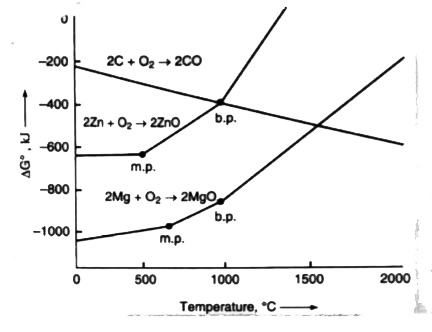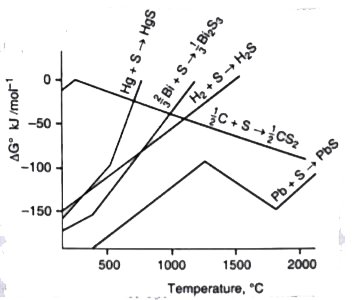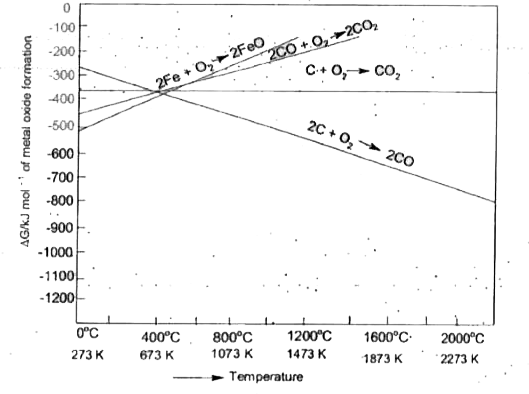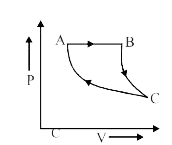The ellingham diagram for zinc, magnesium and carbon coverting into correspondingoxides is shown below.

To make the following reduction process spontaneous, temperature should be :
ZnO+C→Zn+CO
1000∘C
>1100∘C
<500∘C
<1000∘C
The correct Answer is:B
Step by step video & image solution for The ellingham diagram for zinc, magnesium and carbon coverting into correspondingoxides is shown below. To make the following reduction process spontaneous, temperature should be : ZnO+C to Zn+CO by Chemistry experts to help you in doubts & scoring excellent marks in Class 12 exams.
Updated on:21/07/2023Topper's Solved these Questions
- METALLURGYBOOK - VK JAISWAL ENGLISHCHAPTER - METALLURGYEXERCISE - Level 3 (Passive 3)
6 Videos
- METALLURGYBOOK - VK JAISWAL ENGLISHCHAPTER - METALLURGYEXERCISE - Level 3 (Passive 4)
4 Videos
- METALLURGYBOOK - VK JAISWAL ENGLISHCHAPTER - METALLURGYEXERCISE - Level 3 (Passive 1)
8 Videos
- ENVIRONMENTAL CHEMISTRYBOOK - VK JAISWAL ENGLISHCHAPTER - ENVIRONMENTAL CHEMISTRYEXERCISE - ASSERTION-REASON TYPE QUESTIONS
14 Videos
- p-BLOCK ELEMENTSBOOK - VK JAISWAL ENGLISHCHAPTER - p-BLOCK ELEMENTSEXERCISE - SUBJECTIVE PROBLEMS
35 Videos
Similar Questions
The ellingham diagram for zinc, magnesium and carbon coverting into correspondingoxides is shown below.

At 1100∘C, which reaction is spontaneous to a maximum extent ?
View SolutionThe ellingham diagram for zinc, magnesium and carbon coverting into correspondingoxides is shown below.

At 1100∘C, which reaction is spontaneous to a maximum extent ?
View SolutionThe ellingham diagram for zinc, magnesium and carbon coverting into correspondingoxides is shown below.

At what temperature, zinc and carbon have equal affinity for oxygen ?
View SolutionThe ellingham diagram for zinc, magnesium and carbon coverting into correspondingoxides is shown below.

At what temperature, zinc and carbon have equal affinity for oxygen ?
View SolutionQuestions given below are based on the given diagram for extractive metallurgy.
(iii) The make the following process spontaneous, temperature should be :
ZnO+C→Zn+CO.
View SolutionThe Ellingham diagram for a number of metallic sulphides is shown below.

Which of the following sulphides can not be reduced to metal by H2 at about 1000∘C ?
View SolutionMetals are extracted from their ores by a wide variety of techniques. The most common ores are oxides. Most metals are obtained by direct treatment of theirs ores with chemical agents, but the extraction of certain others require electrolysis. An example of the former type of process is the extraction of iron from its oxide, described by the following equation :
Fe2O3+3C→2Fe+3CO
The relative ease of extraction of a metal from its oxide can be estimated using the Ellingham diagram, as shown in the figure.
The diagram plots the free energies of formation of various oxides per mole of consumed oxygen as a function of absolute temperature.

Which of the following best explains why the free energy of formation of Fe2O3 becomes less negative as the temperature is increased.
View SolutionFor a given thermodynamic process, the P – V diagram is as shown below:
Which of the following is the V – T diagram for the process?
A→B: isobaric
B→C: adiabatic
C→A : isothermal

View SolutionReduction of Fe2O3 with CO is done below 710∘C.
ΔfGӨ is negative at this temperature , this process is spontaneous.
View SolutionAssertion : Reduction of ZnO with carbon is done at 1100∘C.
Reason : At this temperature, ΔG∘ is negative and the process is spontaneous.
View Solution
